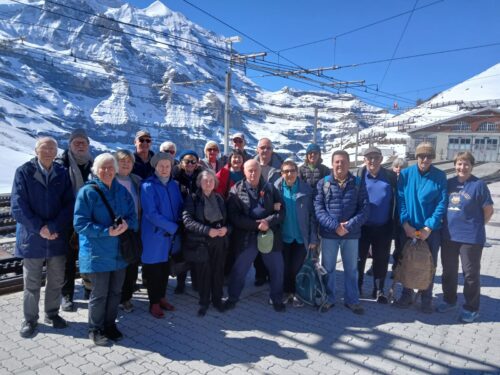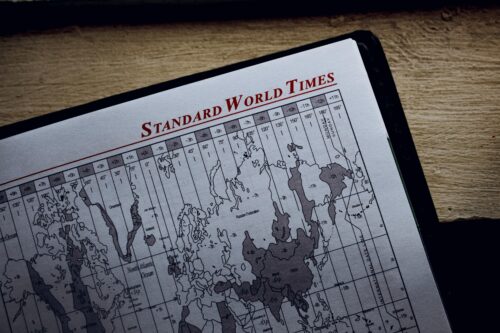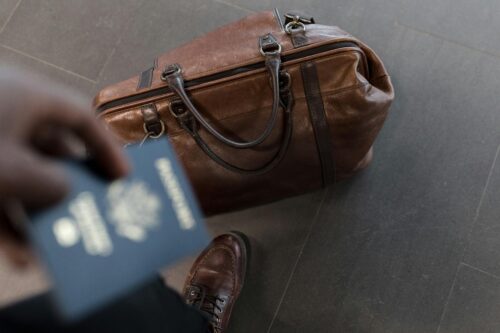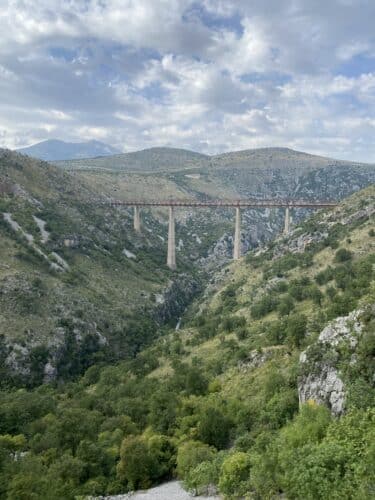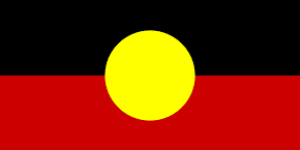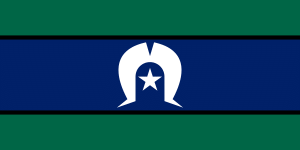The efficient Swiss Railways
Swiss trains run like clockwork, so they say…and they pretty much do. The whole of Switzerland is covered by a frequent, punctual and efficient integrated train network that’s really easy to use, they really are the most convenient and dependable trains in the world. In most cases, you can just turn up, buy a ticket and hop on!
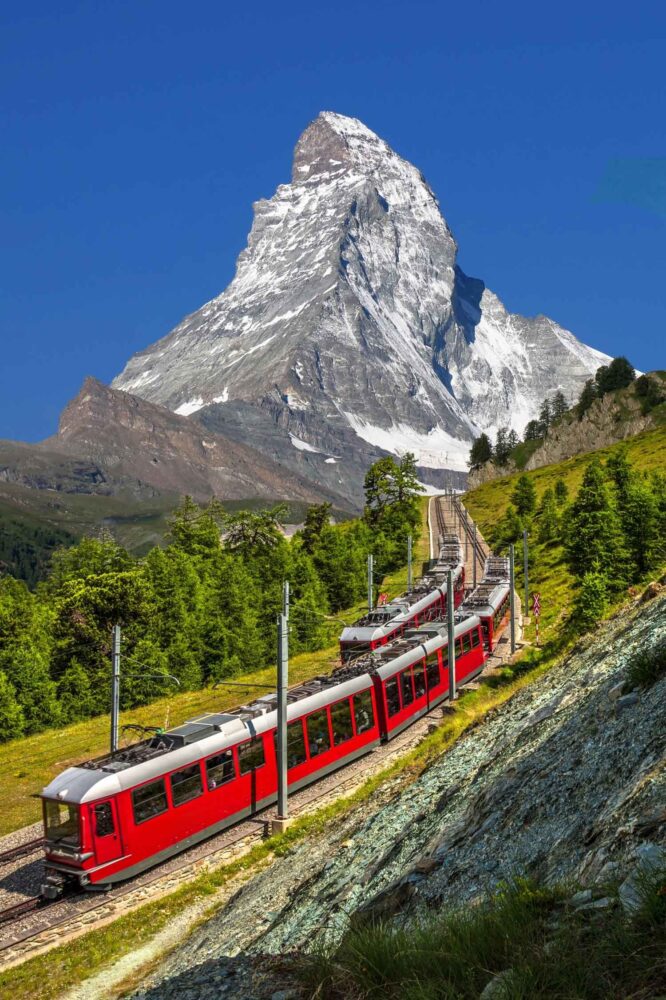
The entire rail system is arranged so that making connections between trains is usually as easy as it possibly can be. Swiss trains are known for their punctuality: 92% of all passengers reached their destination – measured from departure station including any necessary changes – with less than 3 minutes of delay (either 2 or 1-minute delay, or on time) – amazing!
The Swiss are avid train travellers, in 2019 they travelled 19.7 billion passenger kilometres by rail -more often than anyone else in Europe, taking the train an average of 74 times in a year and covering a distance of 2,505km. The Swiss travelled nearly twice as often by rail as people in Luxembourg (40 times), which took the second spot. Worldwide, only the Japanese travel more by train travelling on average 3,400 km per year.
Swiss Federal Railways
Of the country’s 5,100 km of railway, around 3,200 km is operated by the Swiss Federal Railways. Founded in 1902, the former federal organisation became a public limited company in 1999.
Swiss Federal Railways (SBB – Schweizerische Bundesbahnen in German) was ranked first among national European rail systems in the 2017 European Railway Performance Index for its intensity of use, quality of service, and safety rating. While many rail operators in continental Europe have emphasised the building of high-speed rail, SBB has invested in the reliability and quality of service of its conventional rail network, on both national and regional scales. The priority is not so much the speeding up of trains between cities, but the reduction of connection times through the nodal system. Services on the Swiss railway are integrated and with other forms of public transport, such as local railways, postal buses, boats and cable transports, often in direct proximity, to minimise transfer times.
Switzerland has the world’s longest and deepest train tunnel (the Gotthard Base Tunnel with a route length of 57 km), the world’s steepest funicular (the Stoosbahn in Schwyz with a maximum gradient of 110% (47.7°) and Europe’s highest railway station (the Jungfraujoch at 3,454 metres).
To celebrate the 175th anniversary of Switzerland’s first railway, in October 2022, the Swiss set the world record for the longest passenger train. Rhaetian Railway claimed the record after the 1910-metre-long narrow-gauge train (25 four-part electric Capricorn railcars – 100 cars in total) passed through the UNESCO World Heritage route from the Albula Tunnel in Preda to the Landwasser Viaduct. The 25km journey took 1 hour and 10 minutes to complete and was downhill starting at 1,788 metres and descending to 1,000 meters. During the descent, the train – which weighed 3,300 tons – was using electrical regenerative braking and generated 4000 kilowatt-hours of power. It travelled mostly at 30 kmph.
History of rail transport in Switzerland
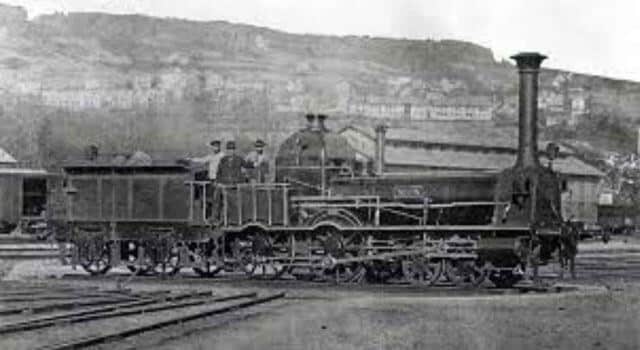
The construction and operation of Swiss railways during the 19th century were carried out by private railways. The first internal line was a 16 km line opened from Zürich to Baden in 1847, operated by the Swiss Northern Railway. By 1860 railways connected western and north-eastern Switzerland but the Alps remained an insurmountable barrier for railways, which need low gradients. The first trans-alpine railway and north-south axis in Switzerland finally opened in 1882. It was the Gotthard Railway, with at its heart the Gotthard Tunnel, passing well below the Gotthard Pass.
Railway gauges in Switzerland
The first railway in Switzerland opened in 1847 between Zürich and Baden and was built to standard 1,435 mm gauge. This gauge was used for much of the subsequent mainline development in the country and international links with neighbouring countries, although a narrow (predominantly metre) gauge was used extensively in the mountainous areas and several important and lengthy cross-country links are metre gauges.
Given its mountainous nature, Switzerland was also a pioneer of rack railways, long sub-alpine tunnels and railway electrification, given the ready availability of hydroelectric power. Almost all of the country’s railways are electrified.
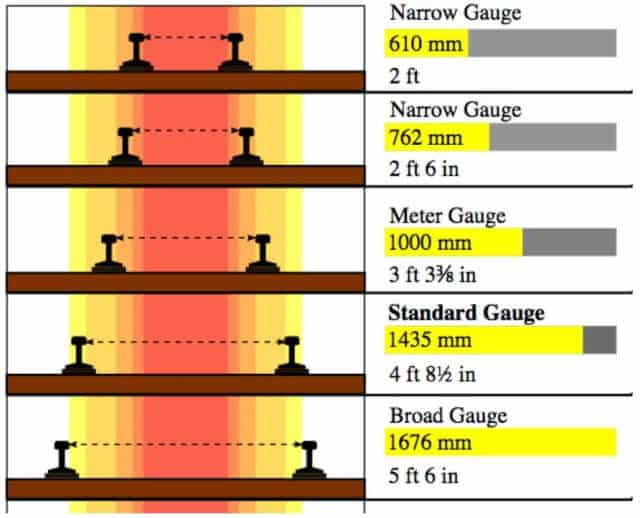
In the Swiss mountains, the importance of having tighter curves meant that a smaller gauge than the standard had to be adopted. This is why Switzerland has a large secondary network that has adopted other gauges, such as the one metre gauge Rhaetian Railway (Rhätische Bahn), the largest metric network in Europe.
Switzerland is one of the few global users that has an extensive network of metre gauge railways, many of which interchange traffic. All street tramways in Switzerland have always been meter gauge. It also uses the common standard gauge of 1,435 mm, the predominant gauge of most of the world including the US.
The major problem with different gauges is of course the impossibility of simply running trains from one network to another. This is why all the networks with a different gauge live separately, as separate technical islands. They can only meet the standard gauge network in stations that accommodate both gauges.
After decades of wrestling with this technological conundrum, in 2008 Switzerland proposed a solution: a bespoke bogie (the part of a train’s undercarriage that supports the wheels) that can narrow or widen to fit the different widths of the two railways, as well as adjust to their different platform heights.
Developed in Switzerland by Alstom, a French multinational rolling stock manufacturer which operates worldwide in rail transport markets the resultant technology is unique. Though variable-gauge bogies exist elsewhere, no other can adapt quite as much as this one, making it a world first for Switzerland.
In December 2022, two new Swiss gauge-changing trains entered service using both metre-gauge and standard-gauge 1,435 mm tracks between Interlaken, in the Bernese Oberland, and Montreux, on Lake Geneva where the secondary networks can be connected with a few steps to the platforms of the SBB national network at 1, 435 mm. The system not only changes the wheelset gauge but also raises and lowers the car bodies’ height and steps below the doors to accommodate the different heights of the narrow and standard-gauge platforms, which vary by as much as 180mm.
Swiss Railway Clocks
The Swiss Federal Railways clock designed by Swiss engineer and designer Hans Hilfiker has become a national icon. It is special in that it stops for just over a second at the end of each minute, to wait for a signal from the master clock which sets it going again — thus keeping all station clocks synchronised.
The clock owes its technology to the particular requirements of operating a railway. First, railway timetables do not list seconds; trains in Switzerland always leave the station on the full minute. Secondly, all the clocks at a railway station have to run synchronously to show reliable time for passengers and railway personnel anywhere on or around the station.
The station clocks in Switzerland are synchronized by receiving an electrical impulse from a central master clock at each full minute, advancing the minute hand by one minute. The second hand is driven by an electrical motor independent of the master clock. It requires only about 58.5 seconds to circle the face, then the hand pauses briefly at the top of the clock. It starts a new rotation as soon as it receives the next minute impulse from the master clock. This movement is emulated in some of the licensed timepieces made by Mondaine.
The top 5 railway adventures you will experience on the Swiss Alpine Adventure by Rail tour
The Glacier Express
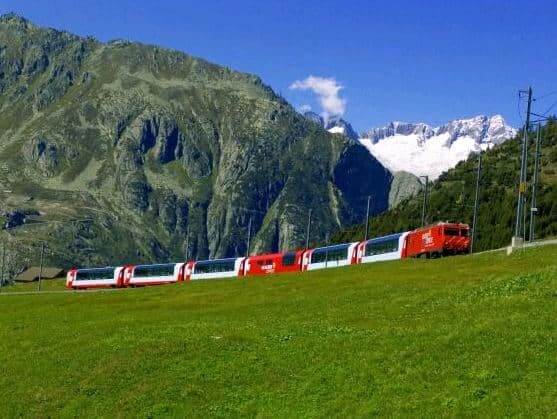
The Glacier Express is known as the slowest express train in the world connecting railway stations of the sophisticated mountain resorts of Zermatt and St. Moritz via Andermatt in the central Swiss Alps. For much of its spectacular journey, it passes along and through the World Heritage Site known as the Rhaetian Railway. The Glacier Express delights travellers with scenic attractions and technical state-of-the-art achievements and has panoramic windows with unobstructed views of unique landscapes. The train is not an “express” in the sense of being a high-speed train, but rather, in the sense that it provides a one-seat ride for an 8-hours-long end-to-end 291 km journey, and omits stops made by local trains. The entire line is metre gauge (narrow gauge), with 23.9 kilometres using the rack-and-pinion system for ascending steep grades and controlling descent.
The Jungfrau Railway
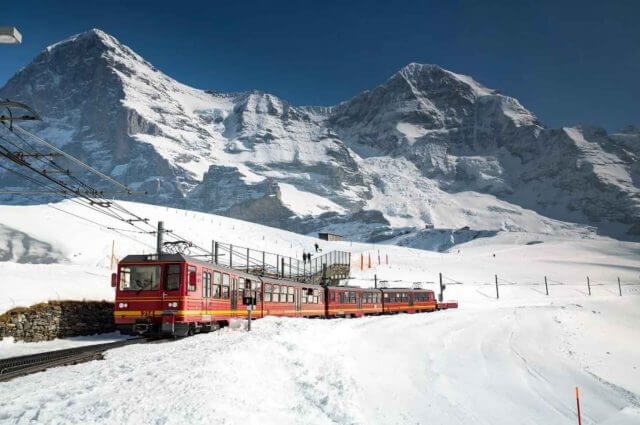
For more than 100 years, the Jungfrau railway has been making its journey to Europe’s highest-altitude railway station at 3,454 metres – right at the heart of the UNESCO heritage site Swiss Alps Jungfrau-Aletsch. All through the year, the cog railway runs steeply up through a tunnel to the Jungfraujoch from Kleine Scheidegg. The tunnel leading up from the station Eigergletscher is 7 kilometres in length and was built between 1896 and 1912. One stop within the tunnel offers spectacular views of the glacier world outside through windows in the Eiger North Face. On the summit, visitors are greeted by a high-Alpine wonder world made of ice, snow and rocks. All of this can be marvelled at from the viewing platforms Sphinx and Plateau on the Aletsch Glacier or from the Ice Palace. You certainly are on the top of Europe: a visit to the Jungfraujoch puts a jewel in the crown of any visit to Switzerland.
The Bernina Express
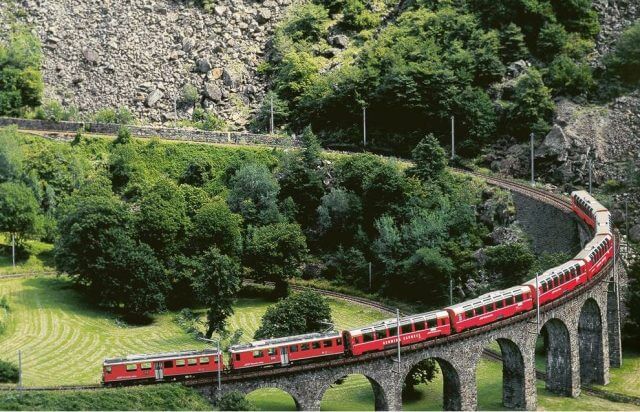
The Bernina Express connects Chur to Poschiavo in Switzerland and Tirano in Italy by crossing the Swiss Engadin Alps. Crossing the Alps in the Bernina Express certainly is one of the most spectacular ways to do it. Along the way, the Bernina Express through incredible alpine landscapes and rolls over the 65-metre-high Landwasser Viaduct, the signature structure of the Rhaetian Railway and the UNESCO World Heritage site. The trip on the Bernina Express is a four-hour railway journey across 196 bridges, through 55 tunnels and across the Bernina Pass at 2,253 metres above the sea. The entire line is 1,000 mm and electrified. This iconic journey is one of the most popular in the country.
Gornergrat Cog Railway
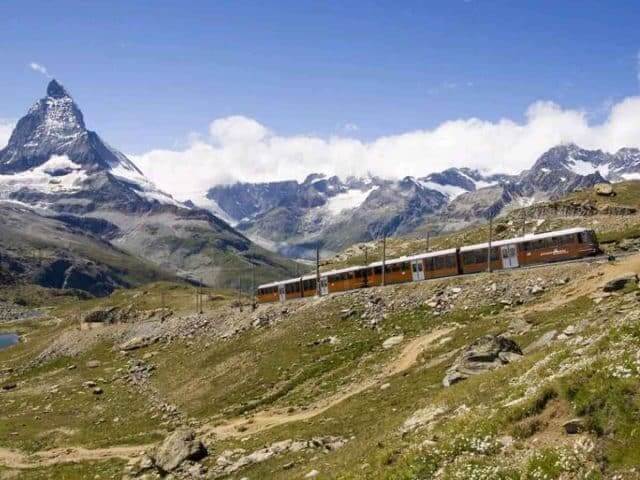
Surrounded by no fewer than 29 peaks above 4,000 meters, such as the majestic Matterhorn and the Dufourspitze as well as the third-longest glacier of the Alps, Gornergrat rewards visitors with unparalleled views. The Gornergrat Railway is a mountain rack railway linking the resort village of Zermatt at 1,603 m to the summit of the Gornergrat. In around 33 minutes the electrified cog railway takes you to the summit through beautiful landscapes, tunnels and bridges. The Gornergrat railway station is situated at an altitude of 3,089 m, which makes the Gornergrat Railway the second highest railway in Europe after the Jungfrau. The Gornegrat Railway was the highest railway in Europe until the opening of the Jungfrau Railway in 1912.
Mount Rigi Cogwheel Railway
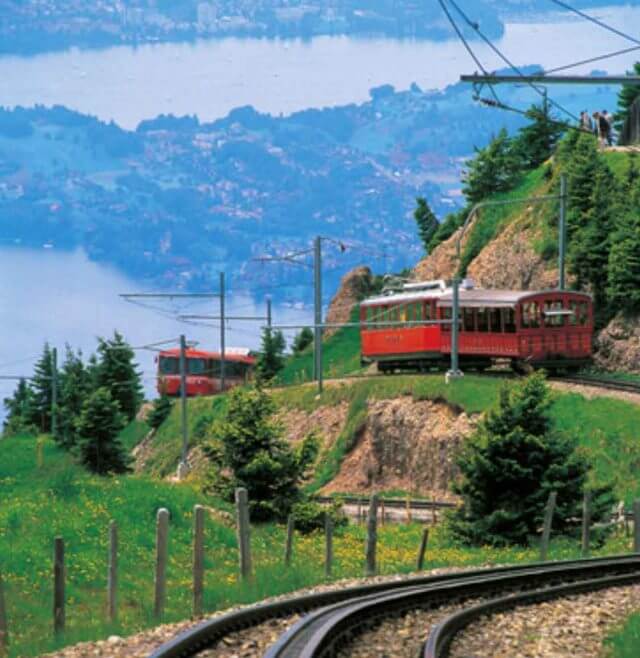
As the first mountain railway in Europe, it has been transporting guests comfortably from Vitznau up to the impressive heart of the mountains since 1871. During the 30-minute ascent by cog railway to almost 1,800m above sea level, visitors can enjoy spectacular views over the lake landscape, passing grazing cows, traditional farms and colourful wildflower meadows. The Mt. Rigi locomotive is still used in historic rides. Built in 1858, it is the oldest Swiss loco surviving and also the only remaining standard gauge rack-fitted vertical boilered loco in the world. The definition of a rack railway (also cogwheel railway) is a steep grade railway with a toothed rack rail, usually between the running rails. Trains are fitted with one or more cog wheels or pinions that mesh with this rack rail. This allows the trains to operate on steep grades above around 7 to 10%, which is the maximum for friction-based rail.
Our experienced and friendly Customer Service Team are always on hand to answer any questions you may have, call us on 1300 800 977 or email us at info@railwayadventures.com to request a brochure on our tours in 2023/24 or visit our website to view all our tours.
Scott McGregor’s Railway Adventures tour is more than just a holiday, it is a unique way to experience the world. By train you are completely immersed in culture and adventure, exploring the most scenic corners of the world in the comfort of a luxury train. Whether you are an experienced traveller or just beginning to explore this wonderful world, Railway Adventures has something for everyone. Transform your holiday into the most unforgettable adventure of a lifetime with Railway Adventures.

